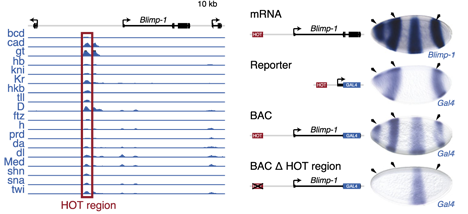
HOT regions function as patterned developmental enhancers and have a distinct cis-regulatory signature
HOT (highly occupied target) regions bound by many transcription factors are considered to be one of the most intriguing findings of the recent modENCODE reports, yet their functions have remained unclear. We tested 108 Drosophila melanogaster HOT regions in transgenic embryos with site-specifically integrated transcriptional reporters. In contrast to prior expectations, we found 102 (94%) to be active enhancers during embryogenesis and to display diverse spatial and temporal patterns, reminiscent of expression patterns for important developmental genes. Remarkably, HOT regions strongly activate nearby genes and are required for endogenous gene expression, as we show using bacterial artificial chromosome (BAC) transgenesis. HOT enhancers have a distinct cis-regulatory signature with enriched sequence motifs for the global activators Vielfaltig, also known as Zelda, and Trithorax-like, also known as GAGA. This signature allows the prediction of HOT versus control regions from the DNA sequence alone.
Supplementary Data: Kvon-Stampfel-Genes_Dev-2012
Featured in a Perspective by Farley and Levine:
HOT DNAs: a novel class of developmental enhancers by Emma Farley and Michael Levine
Kvon EZ*, Stampfel G*, Yáñez-Cuna JO, Dickson BJ, Stark A. HOT regions function as patterned developmental enhancers and have a distinct cis-regulatory signature. Genes Dev. 2012 Apr 12. [Epub ahead of print].
* equal contribution